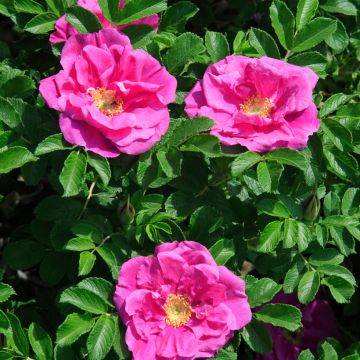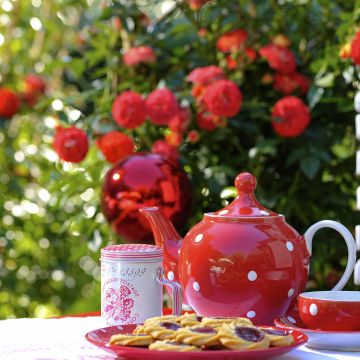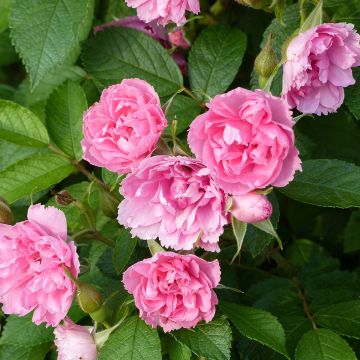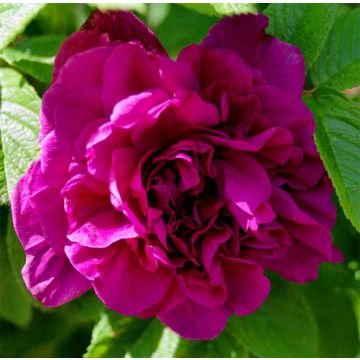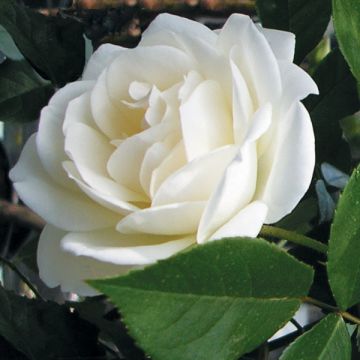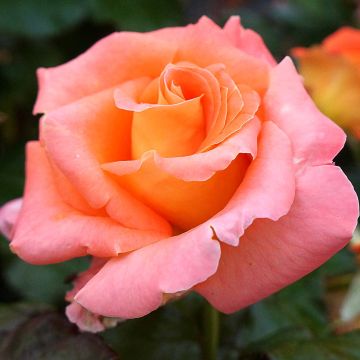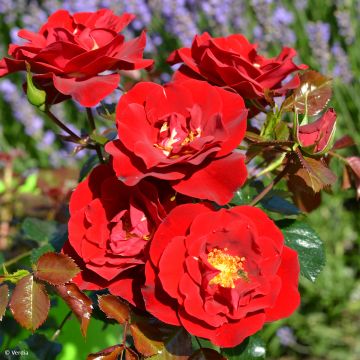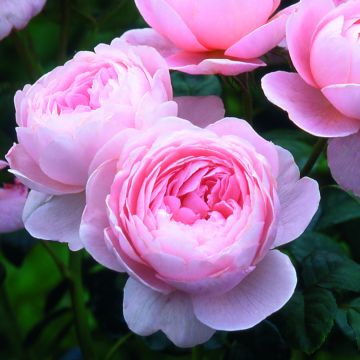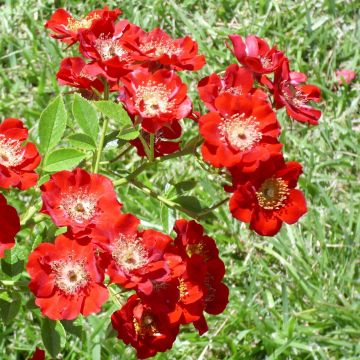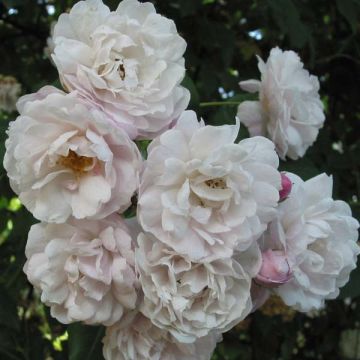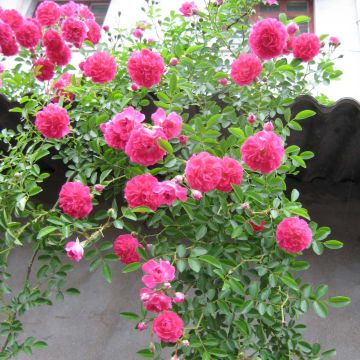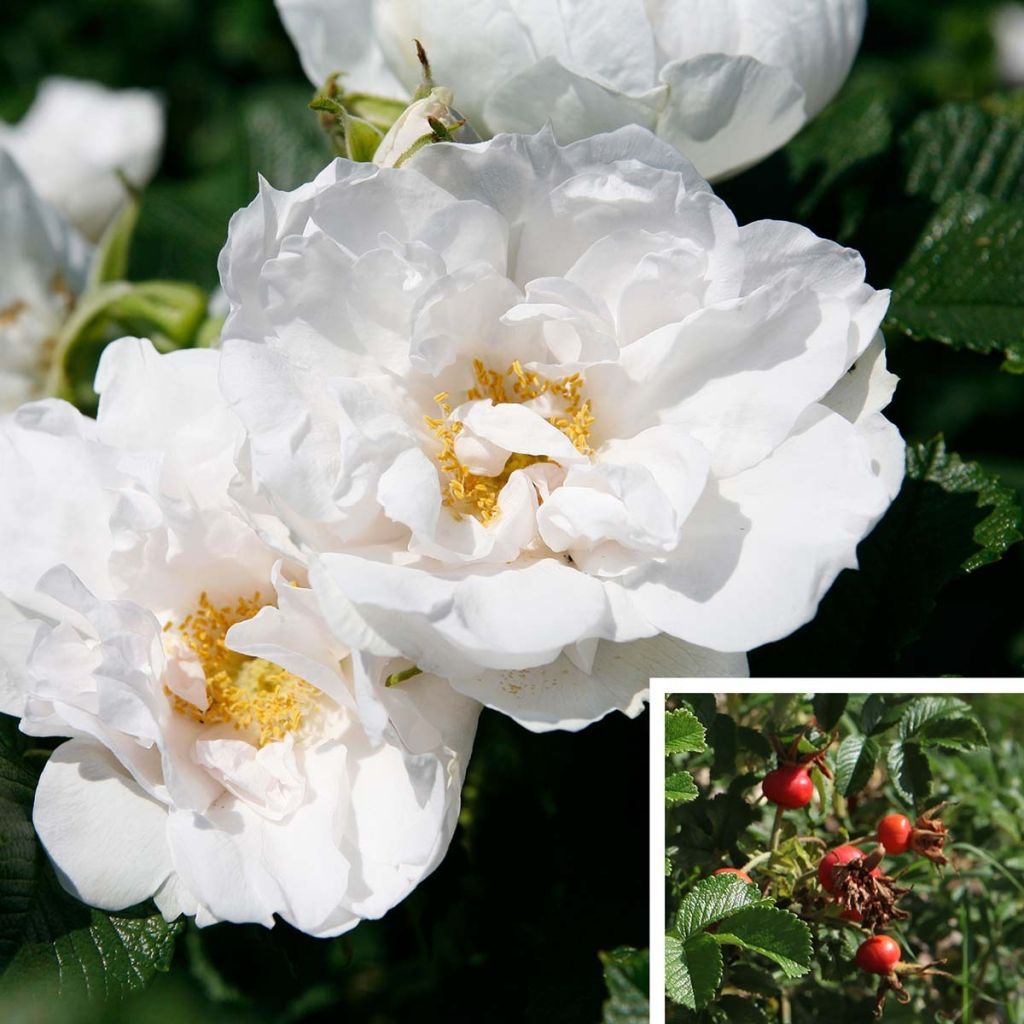

Rosa x rugosa 'SavoraNova White' - Rugosa Rose
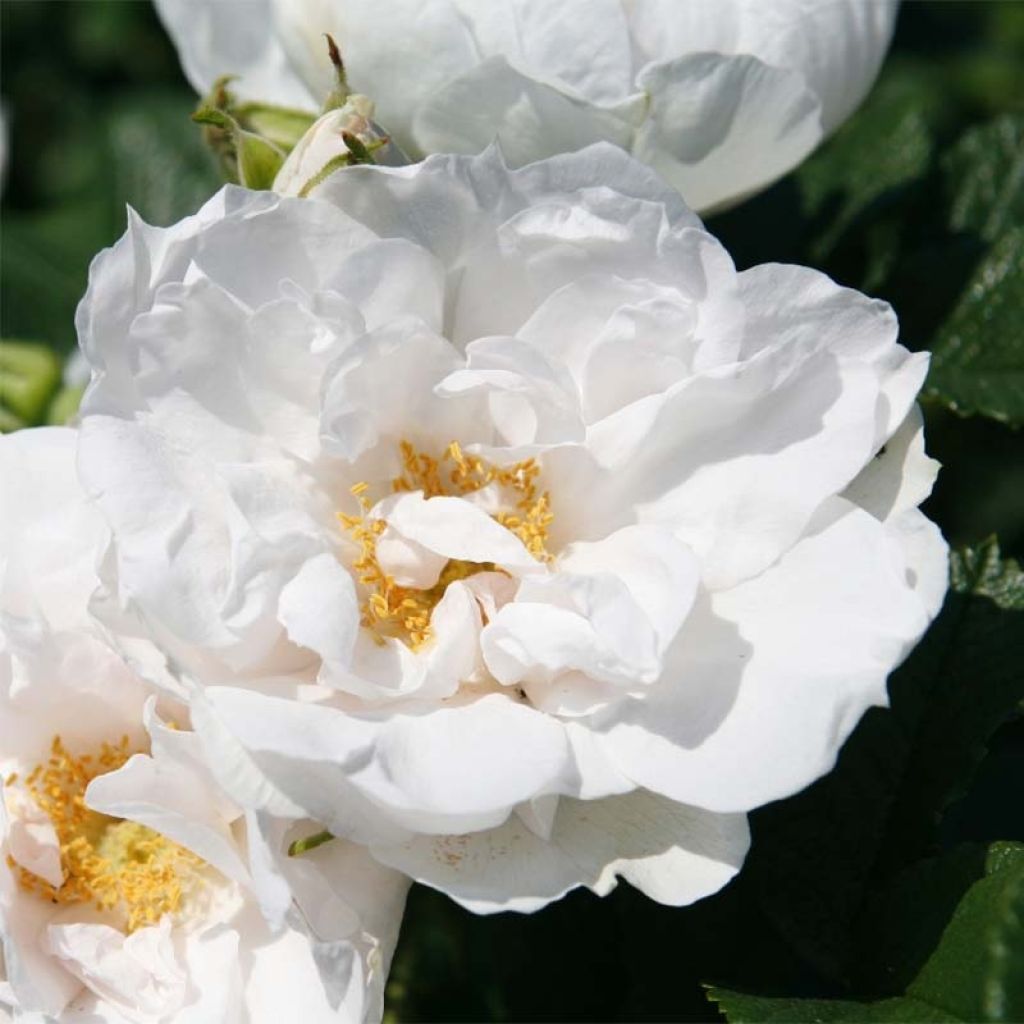

Rosa x rugosa 'SavoraNova White' - Rugosa Rose
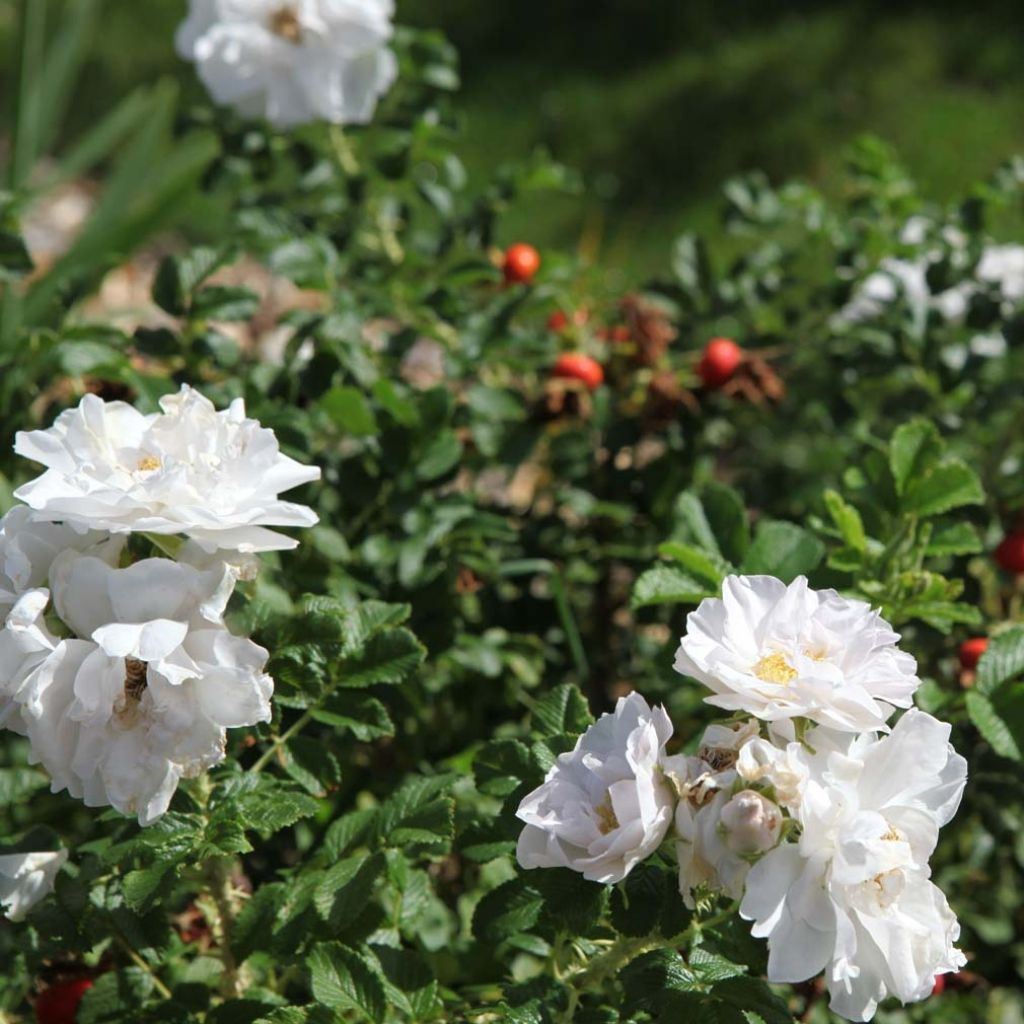

Rosa x rugosa 'SavoraNova White' - Rugosa Rose
Rosa x rugosa 'SavoraNova White' - Rugosa Rose
Rosa x rugosa SAVORANOVA® White® Uhlsylt
Uhlsylt, Rugosa Rose, Japanese Rose, Ramanas Rose, Beach Rose
This plant carries a 24 months recovery warranty
More information
We guarantee the quality of our plants for a full growing cycle, and will replace at our expense any plant that fails to recover under normal climatic and planting conditions.
From €5.90 for pickup delivery and €6.90 for home delivery
Express home delivery from €8.90.
Delivery to Corse prohibited: UE law prohibits the import of this plant from mainland France to Corse as part of the fight against Xylella fastidiosa. Please accept our sincere apologies.
More information

Does this plant fit my garden?
Set up your Plantfit profile →
Description
The Rose 'SavoraNova White' is part of a new series of hybrid roses from the rugosa rose. It is a sturdy wild species that has passed on its beautiful disease-free crinkled foliage and large decorative and tasty fruits. This one is a compact and easy-to-grow small bush that blooms continuously throughout the summer with a subtle scent of wild rose, offering beautiful crumpled corollas, white with a golden heart. The plant still produces roses in October, accompanied by sizeable pulpy red-orange rose hips, very rich in vitamin C. In the garden, it is perfect in a small flowering hedge or a border. The 'Savoranova' roses, with their small size, are also well suited for container gardening.
The fragrant SavoraNova roses result from a close partnership between Globe Planter and the German rose breeder Kordes, who has been creating roses for over 100 years. They are known for producing edible, tasty, and highly fragrant fruits, also known as rose hips, which can be used in many delicious recipes: jam, jelly, macarons, tea, herbal teas, unconventional cooking... They all have obtained the ADR label, awarded according to specific criteria to exceptional rose varieties, particularly disease-resistant and hardy. The SavoraNova range comprises 5 roses: Pink SavoraNova - White SavoraNova - Romantic SavoraNova - Smart SavoraNova - Purple SavoraNova.
The White 'Uhlsylt' Rose quickly forms an upright and bushy bush, reaching about 70 cm (28in) in height and 60 cm (24in) in width. The deciduous foliage turns yellow before falling in autumn. Abundant at the base of the plant, it is composed of crinkled leaves with toothed edges, divided into 5 to 9 very vibrant green leaflets. Its semi-double and solitary flowers, 5 to 6 cm (2in) wide, are pure white and have a silky appearance. They open up to a wide heart with golden stamens. The flowering continues uninterrupted from May to June until October if the soil remains moist in summer. The plant can tolerate a lack of water in summer but will wait for the return of rain to bloom again. Their rose scent is delightful. Its large red-orange fruits are fleshy and edible, with numerous seeds, and rich in vitamin C.
The Savoranova White rose, very hardy and almost maintenance-free, is pruned into a ball shape in March. Essential in a garden without a gardener, perfect in small spaces, it allows flower enthusiasts without a garden to enjoy its scent, flowers, and fruits for long months. Descendants of the rugosa rose are particularly recommended in poor soils or difficult climates because they are undemanding, hardy, and water-saving. This 'Smart' variety will find its place in a small hedge planted en masse or mixed with other flowering or fruiting shrubs (dwarf buddleias, caryopteris, spireas, dwarf raspberry, compact blueberry, hawthorn...)
Recipe for SavoraNova rose fruit jam (source: Globe Planter):
- Harvest the fruits of the roses after the first frost.
- Remove the black tip of the rose fruit, cut each fruit in half and scrape out the inside to remove the seeds and urticating hairs. Then, put the fruits in a bowl and cover them with water.
- Mix a little, and then, using a sieve, remove the remaining hairs on the surface. Rinse the fruits again with running water. Cook them in water (the volume of water should be greater than the fruits) until the flesh of the fruits falls apart (adding water during cooking to prevent the pulp from burning).
- When the pulp is tender, and the juice is well-coloured, remove it from heat and strain it to remove large pieces of peel. Crush against the sides to obtain as much pulp as possible.
- Measure the amount of pulp obtained and add the same weight of sugar.
- Gently bring this mixture to a boil and cook for about 15 minutes. Pour the still-hot preparation into a jar. Then, wipe the jar with a damp cloth to remove any spills on the edges and close it with the lid. Then, turn the jar upside down to create a vacuum (the vacuum is created when the preparation cools down). You will get a magnificent red jam with an original taste and a high vitamin C content that withstands the cooking of the fruit.
Report an error about the product description
Rosa x rugosa 'SavoraNova White' - Rugosa Rose in pictures
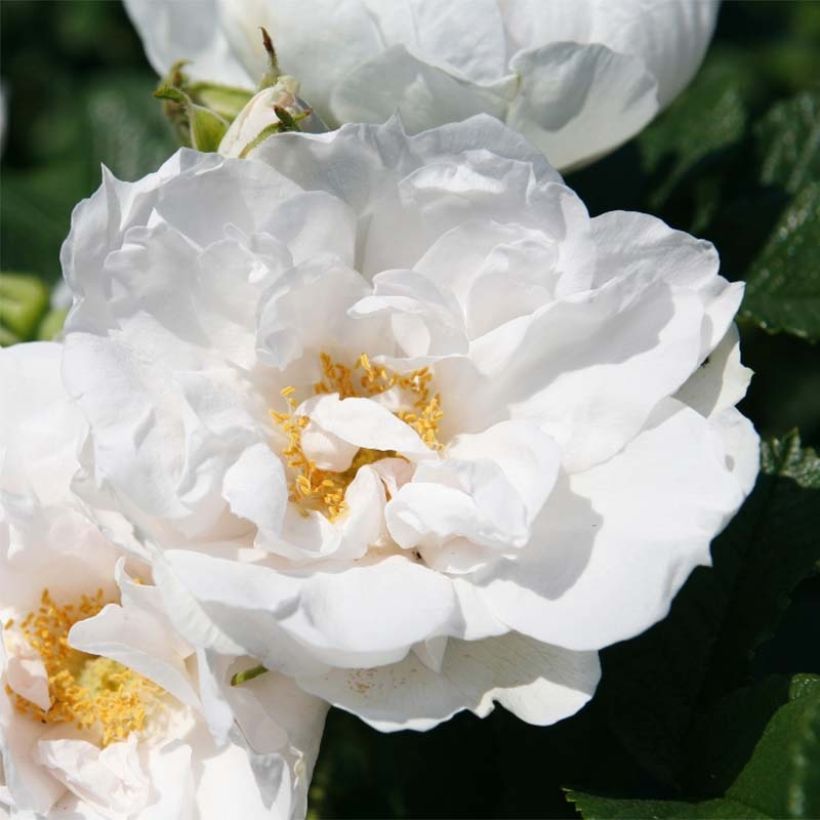

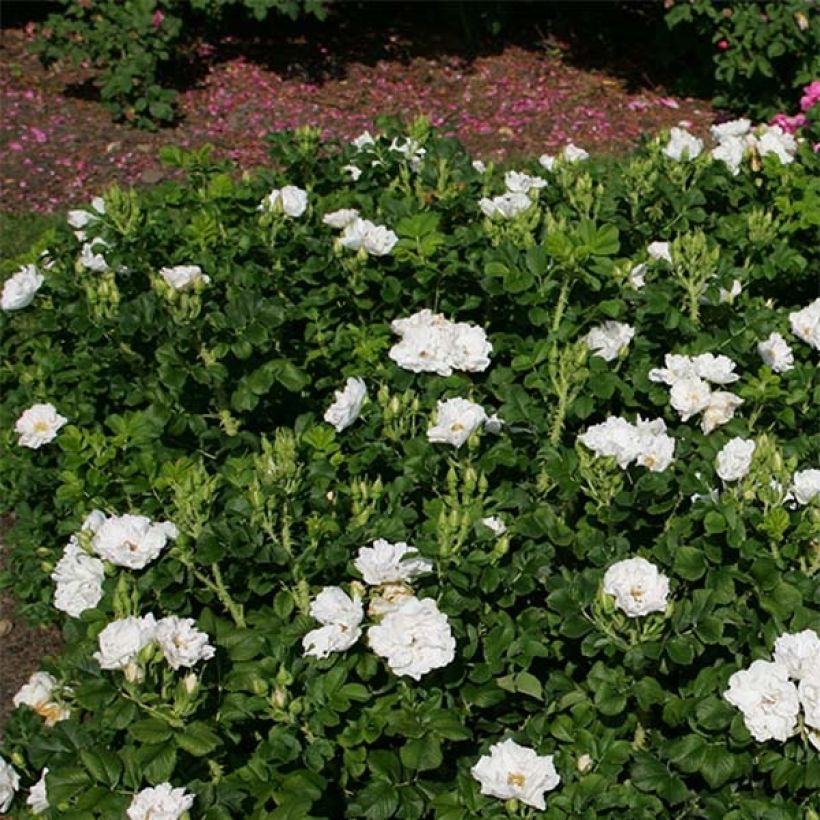

Plant habit
Flowering
Foliage
Botanical data
Rosa
x rugosa
SAVORANOVA® White® Uhlsylt
Rosaceae
Uhlsylt, Rugosa Rose, Japanese Rose, Ramanas Rose, Beach Rose
Cultivar or hybrid
Other Rosa rugosa
Planting and care
The Savoranova rose is an easy-to-care-for plant that can thrive in all regions. It is not vulnerable to diseases, cold, rain, or waterlogged or dry soils. It can adapt to any soil type if the planting is well cared for. The rose should be planted in well-worked, well-amended, and well-drained ordinary soil, and it prefers a sunny or semi-shaded exposure, which it can tolerate very well in hot climates. Maintenance is straightforward to keep the plant bushy: after winter, in March, prune to a ball shape. This rose is very hardy and can withstand temperatures as low as -15 °C (5°F).
To plant your rose, loosen the soil to a depth of 25 cm (10in) and put a background amendment like blood, fish and bone at the bottom of the planting hole. Take your plant out of its pot and position it in the hole, covering the top of the root ball with 3 cm (1in) of soil. Fill in the hole and water it well to remove any air pockets. You should regularly water your plant for a few weeks during dry weather to help it establish strong roots.
Use a special rose fertiliser that stimulates flowering to encourage your rose to flower. You can also bend and tie the branches regularly to promote lateral shoots that will produce clusters of flowers. Don't be afraid to use this technique - it will be worth it.
Finally, removing any faded flowers regularly is essential to encourage new growth.
Roses may develop unsightly spots at the end of summer, but this is a natural occurrence and doesn't harm the rose's growth.
Planting period
Intended location
Care
-
, onOrder confirmed
Reply from on Promesse de fleurs
Roses by purpose
Haven't found what you were looking for?
Hardiness is the lowest winter temperature a plant can endure without suffering serious damage or even dying. However, hardiness is affected by location (a sheltered area, such as a patio), protection (winter cover) and soil type (hardiness is improved by well-drained soil).

Photo Sharing Terms & Conditions
In order to encourage gardeners to interact and share their experiences, Promesse de fleurs offers various media enabling content to be uploaded onto its Site - in particular via the ‘Photo sharing’ module.
The User agrees to refrain from:
- Posting any content that is illegal, prejudicial, insulting, racist, inciteful to hatred, revisionist, contrary to public decency, that infringes on privacy or on the privacy rights of third parties, in particular the publicity rights of persons and goods, intellectual property rights, or the right to privacy.
- Submitting content on behalf of a third party;
- Impersonate the identity of a third party and/or publish any personal information about a third party;
In general, the User undertakes to refrain from any unethical behaviour.
All Content (in particular text, comments, files, images, photos, videos, creative works, etc.), which may be subject to property or intellectual property rights, image or other private rights, shall remain the property of the User, subject to the limited rights granted by the terms of the licence granted by Promesse de fleurs as stated below. Users are at liberty to publish or not to publish such Content on the Site, notably via the ‘Photo Sharing’ facility, and accept that this Content shall be made public and freely accessible, notably on the Internet.
Users further acknowledge, undertake to have ,and guarantee that they hold all necessary rights and permissions to publish such material on the Site, in particular with regard to the legislation in force pertaining to any privacy, property, intellectual property, image, or contractual rights, or rights of any other nature. By publishing such Content on the Site, Users acknowledge accepting full liability as publishers of the Content within the meaning of the law, and grant Promesse de fleurs, free of charge, an inclusive, worldwide licence for the said Content for the entire duration of its publication, including all reproduction, representation, up/downloading, displaying, performing, transmission, and storage rights.
Users also grant permission for their name to be linked to the Content and accept that this link may not always be made available.
By engaging in posting material, Users consent to their Content becoming automatically accessible on the Internet, in particular on other sites and/or blogs and/or web pages of the Promesse de fleurs site, including in particular social pages and the Promesse de fleurs catalogue.
Users may secure the removal of entrusted content free of charge by issuing a simple request via our contact form.
The flowering period indicated on our website applies to countries and regions located in USDA zone 8 (France, the United Kingdom, Ireland, the Netherlands, etc.)
It will vary according to where you live:
- In zones 9 to 10 (Italy, Spain, Greece, etc.), flowering will occur about 2 to 4 weeks earlier.
- In zones 6 to 7 (Germany, Poland, Slovenia, and lower mountainous regions), flowering will be delayed by 2 to 3 weeks.
- In zone 5 (Central Europe, Scandinavia), blooming will be delayed by 3 to 5 weeks.
In temperate climates, pruning of spring-flowering shrubs (forsythia, spireas, etc.) should be done just after flowering.
Pruning of summer-flowering shrubs (Indian Lilac, Perovskia, etc.) can be done in winter or spring.
In cold regions as well as with frost-sensitive plants, avoid pruning too early when severe frosts may still occur.
The planting period indicated on our website applies to countries and regions located in USDA zone 8 (France, United Kingdom, Ireland, Netherlands).
It will vary according to where you live:
- In Mediterranean zones (Marseille, Madrid, Milan, etc.), autumn and winter are the best planting periods.
- In continental zones (Strasbourg, Munich, Vienna, etc.), delay planting by 2 to 3 weeks in spring and bring it forward by 2 to 4 weeks in autumn.
- In mountainous regions (the Alps, Pyrenees, Carpathians, etc.), it is best to plant in late spring (May-June) or late summer (August-September).
The harvesting period indicated on our website applies to countries and regions in USDA zone 8 (France, England, Ireland, the Netherlands).
In colder areas (Scandinavia, Poland, Austria...) fruit and vegetable harvests are likely to be delayed by 3-4 weeks.
In warmer areas (Italy, Spain, Greece, etc.), harvesting will probably take place earlier, depending on weather conditions.
The sowing periods indicated on our website apply to countries and regions within USDA Zone 8 (France, UK, Ireland, Netherlands).
In colder areas (Scandinavia, Poland, Austria...), delay any outdoor sowing by 3-4 weeks, or sow under glass.
In warmer climes (Italy, Spain, Greece, etc.), bring outdoor sowing forward by a few weeks.

































